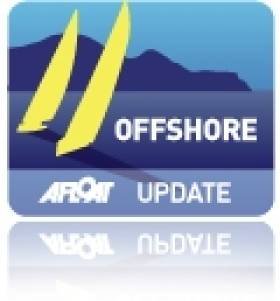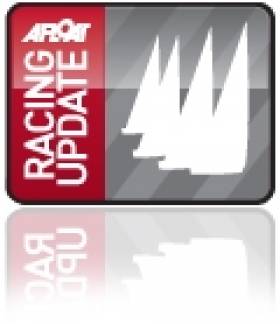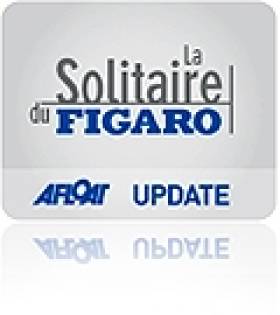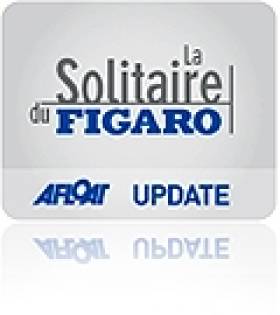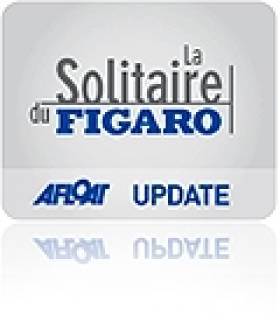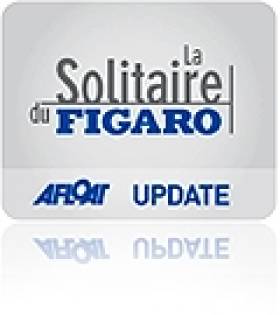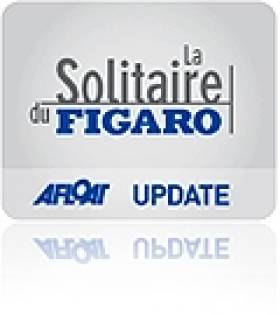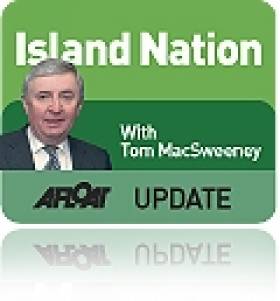Displaying items by tag: David Kenefick
David Kenefick On His Way Rolex Middle Sea Race
#RolexMiddleSea - Irish solo sailing sensation David Kenefick will be racing in company abroad the Artemis IMOCA 60 that's currently en route to the Rolex Middle Sea Race tat starts on Saturday 17 October.
The Afloat.ie Sailor of the Year for 2013 will be sailing the 606-mile offshore route in a fleet that includes many experienced professionals from the America's Cup and Volvo Ocean Race, not to mention the record-breaking MOD 70 trimaran Musandam-Oman Sail.
It's a a veritable best of the best - but Kenefick has demonstrated before that he has the skills to fit right in.
Foxall & Kenefick Perform in Persian Gulf
#tourofarabia – Cork and Kerry offshore sailors continue a strong performance in the Persian Gulf this week with Damian Foxall's Oman sail/EFG crew outwitting Crosshaven's David Kenefick sailing on Team Averda to lead the Tour of Arabia. 'Brutal conditions' were reported over the course of the latest 1100–mile leg with two boats in the seven boat fleet pushing speedo logs up through the hull in slamming wave conditions.
A third place in the final leg was enough to confirm Frenchman Sidney Gavignet and his mixed Omani and European team overall winners of EFG Sailing Arabia – The Tour for the second year in a row. EFG Bank (Monaco) were not the only champions in Bahrain on Saturday however with the new Volvo Ocean Race Rookie Award for the top two Under 30 sailors of the event going to Team Renaissance Omani sailor, Ali Al Balushi and British sailor from the University of Plymouth team, Richard Mason.
A course change from east to west for the 2015 edition resulted in 14-days of testing upwind racing on the six-leg, 760-nautical mile course from Oman to Bahrain. Noted for being one of the toughest on record, the 11 pro-am racing teams with crews from 21 different nations experienced a truly unique, highly competitive, cultural adventure.
Gavignet and crew; Damian Foxall (IRL), Alex Pella (ESP), Nicolas Lunven (FRA), Fabien Delahaye (FRA), Mohammed Al Mujaini (OMA), Abdull Rahman Al Mashari (OMA), and Abdallah Al Shukaili (OMA), sailed an impressive series but they didn't have it all their own way.
They were chased hard throughout by Marcel Herrera and his young student team from Plymouth University on Team Averda, who took second overall, and Zain Sailing Team from Kuwait headed by seasoned Tour competitor Cédric Pouligny with Gérald Véniard navigating, who finished third.
Gavignet was delighted with the result: "It feels good to have achieved the goal we set, we had a great atmosphere onboard, which I believe helped our performance."
"It is clearly harder and longer than previous editions. I believe the tougher it is, the more its reputation will grow particularly for pro Volvo Ocean Race teams looking for a training ground."
The three Omanis onboard the EFG Bank (Monaco) winning team, plus the Omani Renaissance crew and Navy of Oman team are testimony to Oman Sail's vision of developing the region's sailing talent and rekindling its rich maritime heritage through creating role models to inspire the next generation of sailors.
Kerry-born Damian Foxall, Ireland's greatest offshore sailor, was enthusiastic about the progress made: "This event is a good tool to validate the progress of the Omanis. In previous years the crews struggled to visualise what the life of a professional sailor could be like. Now I think they like the idea which helps them progress quicker."
As one of the toughest on record, the 2015 event has endorsed its status as a prime option for professional teams seeking winter training venues and for young aspiring offshore sailors seeking a race that will put them to the test. Volvo Ocean Race recognition of the event as a leading development race for young offshore sailors and the new Volvo Rookie Award for the top two Under 30 sailors has added another avenue of competition. This year's lucky recipients will be flown to Newport, one of the Volvo stopovers for a weekend to watch the in port and pro am racing.
"EFG Sailing Arabia – The Tour is tough, even for hardened Irish sailors like me," said Foxall. "But the Tour package makes life really easy for teams that want to just turn up and race. You can concentrate on the sailing and not have to worry about boat prep because there's a technical team on hand all the way."
Three members of the Chinese Volvo Ocean Race team Dongfeng used the event as a tool to enhance their performance. Kit Cheng from Hong Kong said: "It was tougher than Leg 3 of the Volvo, so for training purposes, it is perfect!"
Second placed Marcel Herrera, skipper of British boat Team Averda, was thrilled with his result: "This shows consistency and proves that last year wasn't just a fluke. I am very happy with our result."
The all-Omani team who finished fifth aboard Team Renaissance gave an indication of how the Omani sailors have progressed. Their best result was a second place on Leg 5 – the toughest in the five-year history of the event. Fahad Al Hasni, a regular on the Oman Sail MOD70 trimaran and skipper for EFG SATT, said: "We have improved such a lot as a team, and I have every reason to believe we'll be on the podium in 2016."
With more and more teams recognising EFG Sailing Arabia – The Tour as a prime event on the global circuit, this unique Middle East sailing adventure is on the brink of progressing to a new level with the potential of an even larger, more competitive fleet next year.
Overall Results
EFG Bank (Monaco) 12pts
Team Averda (UK) 21.25pts
Zain (KUW) 29.50pts
TU Delft (NED) 29.75pts
Renaissance (OMA) 39pts
Al Thuraya (OMA) 41.75pts
Bienne Voile (SUI) 42.75pts
GAC powered by DongFeng (CHN) 44.50pts
OMIFCO (OMA) 64pts
Royal Navy Oman (OMA) 69pts
IMCO (OMA) 70.25pts
Irish Sailors Arabian Tour De Force: Foxall First, Kenefick Second In Sailing Arabia Leg One
#SailingArabia – After 21 hours of racing, Ireland's top offshore sailor Damian Foxall on EFG Bank (Oman) has won the opening leg of the Tour of Arabia. Second was Royal Cork's David Kenefck as a driver/trimmer on Team Avera.
The wind increased to eight knots for a time before the finish for Foxall to cross the line on a close reach with spinnakers up. Although winds remain light, the Race officer is optimistic that all eleven boats will finish within the time limit.
As Afloat.ie reported a week ago, The Tour is contested in a fleet of Farr 30 yachts and visits marinas in the Arabian Gulf. The event started at Muscat, then follows the fleet to Sohar and around the Musandam Peninsula to the UAE, Qatar and Bahrain.
#lasolitaire – Three winners, five Rookies and counting - 20 skippers registered so far for the 46th edition of La Solitaire du Figaro - Eric Bompard Cachemire. The last two editions of the race have featured Cork entry David Kenefick but there is no Irish registration so far but potentially a Rookie entry from County Down. Andrew Baker, a member of the Artemis Offshore Academy, is in the running for a place on the start line, but first he has three practice races to earn his spot. The decision will be announced in May.
And in other exciting offshore sailing news for Ireland, a County Meath sailor has launched a Mini Transat solo sailing campaign for 2015.
With four months to the start of the 46th La Solitaire du Figaro - Eric Bompard Cachemire, 20 intrepid Figaro skippers have signed up to the 2185 mile, month long solo offshore race.
Kicking off on the 31st May from Bordeaux (France), as many as 45 solo skippers and their 33ft Figaro Beneteau IIs are expected to race from the grand city of Bordeaux to Sanxenxo (Spain), Concarneau (France), Torbay (UK) and across the final finish line in Dieppe (France) in July.
This year's early entry list is already evidence of the Solitaire's universal appeal, with registered entrants ranging from race champions and Vendee Globe winners, to talented regulars chipping away at the top 10, rank outsiders and ambitious first timers.
Triple Solitaire du Figaro winner Jeremie Beyou (Maitre Coq) (2005, 2011, 2014) returns to the race in 2015 not only to defend his title, but also with an aim to become the first skipper to have ever won the Solitaire four times.
Making their debut on the Class Figaro circuit in 2015, five ambitious Rookies have signed up for this epic solo marathon so far.
Also joining the fleet but not yet on the list, the Artemis Offshore Academy will contribute as many as three of its talented UK brood to the Rookie fleet. This year British Rookies Rob Bunce, Andrew Baker and Robin Elsey are out to earn themselves a place on the start line. This decision will be announced in May.
Skippers currently registered:
Skipper/boat name/nationality/*Rookie
1. Marc Pouydebat/TBC/FRA/Rookie*
2. Yann Elies/ Groupe Queguiner-Leucemie Espoir)/FRA
3. Jeremie Beyou/Maitre Coq/FRA
4. Benjamin Dutreux/Team Vendee/FRA/Rookie*
5. Gildas Morvan/Cercle Vert/FRA
6. Corentin Horeau/Bretagne Credit Mutuel Performance/FRA
7. Sebastien Simon/Bretagne Credit Mutuel Espoir/FRA
8. Martin le Pape/ Ovimpex-Secours Populaire/FRA/Rookie*
9. Henry Bomby/TBC/GBR
10. Thierry Chabagny/Gedimat/FRA
11. Adrien Hardy/AGIR Environnement/FRA
12. Alain Gautier/Generali/FRA
13. Tolga Pamir/Un jour un home un arbre/TUR/Rookie*
14. Gwenole Gahinet/Safran Guy-Cotten/FRA
15. Claire Pruvot/Port de Caen-Ouistreham/FRA
16. Vincent Bairnes/Guyot Environnement/FRA
17. Benoit Mariette/TBC/FRA/Rookie*
18. Laurent Pellecuer/TBC/FRA
19. Isabelle Joschke/Generali-Horizon Mixite/FRA
20. Corentin Douguet/TBC/FRA
Back to College for Royal Cork Solo Sailor David Kenefick
#fullrish – Since my last blog update quite a lot has happened and as a result things have changed for my sailing campaign writes Figaro solo sailor David Kenefick.
As I said, after the Figaro I was tired and I needed to reflect on a lot of things. I needed some time to recover and reflect on the last 18 months of my life, which frankly has been a whirlwind. And luckily I have been able to do just that.
It was wonderful to come home after the Figaro in July and see so many friends and familiar faces and take time away from the campaign. As I set about recovering which, in fact took me about 4-5 weeks I began thinking about the future. It quickly became apparent there were two options: either keep sailing or finish my College course which I left over 2 years ago to take up the 'Full Irish' project.
The sailing option was made of mainly two different options. One of these was the possibility of trying to put together a 2016 Vendée Globe project. The Vendée Globe is a single-handed non-stop around the world race in IMOCA 60 sailing boats. It is the toughest sailing race on this planet and for sure is one of the toughest challenges known to man.
I thought about this project for a long time and even had a few meetings with people about it. It was then up to me to decide if I wanted to put myself forward and tell the world my crazy plans to have the first ever Irish boat in the Vendée Globe. The complexity of a project like this is not simple, while I took time to think there were a number of things running through my mind. Have I enough experience? Would I ever find the money that I needed? Would I be able to do a good job?
As the time came to try to put my young head on old shoulders I felt I wouldn't be able to find the correct ingredients to put a solid and safe campaign together along with the thought that sailing will always be there and there is a business degree to be finished. So it was back to college.
Today was my 10th day of college lectures the day it really hit home how much I'm going to miss the Figaro and how lucky I was to do two years in this tough and amazing fleet. One thing is for sure I've got more hunger than ever to do the Figaro race again but for now sailing is on hold.
I would like to thank all my sponsors and everyone who has helped me. A particular mention goes to Marcus Hutchison who introduced me to the Figaro and helped me so much.
Solo Sailor David Kenefick Completes Second Figaro Race
#fullrish – Irish solo sailor David Kenefick shares some thoughts at the end of his second Figaro which I finished yesterday in Cherbourg.
The season
This was my second year and my biggest take out from the first year was to keep it as simple as possible. This is already a complicated project without making it harder for myself. Looking back at it now I am pretty satisfied that I wouldn't have changed anything in my preparation if I had to do it again.
I set myself the primary objective of wanting say to myself that I was satisfied with my season and my race when the project was done. Here I am the day after finishing my second Figaro season, four Fastnet races in a month singlehanded on a 32-foot boat SATISFIED. No question about it.
At the beginning of the year I realized I had a 50% chance of doing better than last year's result (28th). I know I sailed much better this year, I was confident with the boat, I had my moments of brilliance that lasted sometimes five minutes sometimes a whole afternoon, sometimes across a couple of days. I know it is about the result at the finish but I also knew inside myself that I sailed well most of the time.
I finished 23rd this year and I know exactly where I made mistakes and exactly how much they cost me. I also understand more and more why this race is so special and so tough. Jeremy Beyou won this year's race, his third victory in 13 attempts. He told me last night it took him nine years to get on the podium for the first time! My biggest lesson this year is quite how hard it is to do well, much harder than I thought this time last year and before I ever began I had no idea what this was about. But that is what makes it special, until you have done it you can't possibly imagine what its really about. Only people who have done the race will understand what I am talking about.
The whole experience was much more enjoyable than last year, of course because I had a vague idea of what I was getting into. Interestingly I slept a lot less this year during the race than last year but I know I am fresher now than this time last year.
Highlights and low points
Without a doubt the start at Deauville was my highlight. Nailing the pin end and rounding the top mark in third and holding all the way round the inshore course until out of sight of land was pretty special. Having my Dad Neil in the spectator fleet there too, watching made it extra special because the whole family has supported me so much in this project.
Probably the next high point was the exciting reach towards the Chausée de Sein in Leg 3. The weather wasn't very nice, drizzle, misty, all a bit tired but the boat going fast in a nice breeze with the big spinnaker set. Then we were hit by a big squall of over 35 knots. Luckily I had put my ballast snorkel down and so the boat filled up with water on the right side just in time and I just hung on driving it hard through the waves at ridiculous speeds on the edge of control whilst most boats around dropped their kites or broached out of control. I noticed Alan Gautier (a past Vendée Globe and Figaro winner) and Xavier Maquaire (2nd in Figaro last year) amongst these boats. I survived the squall, made the mark, gained some places and had a great buzz inside that I had controlled the situation well and made the most of it. Those are the kind of memories you will keep forever.
Then the low points, the scary moments. The first really downer was in leg three approach the BXA mark near Bordeaux. We had been at sea for three days and three nights at that stage, everyone was shattered. I was three miles from the mark which was a 90 degree turn to the North. Normally you are wide awake on the approach to the marks as there are plenty of things about to happen. Anyway, one of our fellow competitors Thierry Chabignet just sailed right past the mark and headed on towards the shore. No one could contact him and his boat sailed on for 30 minutes before we knew what was going on. The only reason that someone doesn't respond or sails past a mark is because they are not on the boat. We all had visions of Thierry floating past us in the water as we approached the mark. One of the escort boats finally got up close to his boat, he woke up and immeadiately put the boat back on course. It turns out he had slept through his alarm his boat had sailed the right side of the mark and just kept going.
On my own boat the scariest moment was on the last morning. We were approaching the West side of Guernsey to get out of the tide. Sailing upwind I had decided to get 15 minutes head down and I must have slept too long. I woke up with a start went up on deck and I swear I was doing six knots two or three boat lengths from a big rock sticking out of the water!!!!
Crash tack, ballast and jib on the wrong side but I saved it. I'm sure my keel was in the weed! If I had slept for 10 seconds more it would have ended differently. Of course on recovering from that I had to tack straight back into the rocks to get out of the tide again, but not sleeping again until last night when I finally got ashore.
The race is rich with stories like this. They are shared with all other competitors and everyone has their's to tell.
Future
It's dangerous to comment on the future the day after you finish this race. I will definitely do this race again. Not sure when but it is too special not to want to do it again. But for now I need to reflect on a lot of things in life. I need some time to recover and reflect on the last 18 months of my life, which frankly have been a whirlwind. I'm a bit tired of being alone and eating meals on my own. I need to reintegrate into society a bit for a while. Right now I have absolutely nothing planned after next week. This is probably the first time in my adult life that this has been the case, a weird feeling but great too.
I will repeat saying this until the day I die, you just can't describe how special this race is. It is brutally hard. Alan Gautier and Jeremie Beyou will tell you it is way tougher than the Vendée Globe, their words not mine. Racing against a clock makes it weird. Anyone out there needs a real mental and physical challenge in their lives needs to tackle this scene. The sense of community amongst the sailors at sea and ashore is also unique. Friends for life, respect for life.
Kenefick Moves into Tenth Position in Figaro Leg Four
#fullrish – The start of leg 4 from Les Sables on Sunday was pretty wild writes Irish solo sailor David Kenefick competing in the La Solitaire du Figaro. 25 knots and a two metre swell in bright sunshine made for a fine spectacle.
The 2.5 mile windward leeward start of the long 490 mile leg to Cherbourg sorted a lot of things out quite quickly with fairly large variations in speed shown straight away.
Spectacular surfs downwind eased the pain of the long upwind slog along the rocky coast and as night fell the fleet was heading West towards the approaching depression.
David made a good start and held his own around the course and on Monday morning is in the top half of the fleet in much lighter airs sailing North past Belle Isle.
Having sailed most of the night upwind into a dropping wind as they crossed the pre-depression ridge the fleet is now reaching with spinnakers heading North West to the Chausée de Sein, the next mark of the course.
But as ever there is a trade-off going on between being further west and getting the better breeze earlier or further north and getting to the mark earlier. The next part of Monday will show us which side of the fleet has got this right.
At 08:00 this morning David was in 10th position on the Eastern side of the fleet. You can follow the tracker on lasolitaire.com
#fullrish – Solo Irish sailor David Kenefick sends Afloat.ie this update from Leg three of the La Solitaire Du Figaro race
That was tough, frustrating and it seemed to be long but in fact it wasn't excessive. I started nicely at the pin end and sailed a good inshore part of the course and enjoyed the fight. I find that its so much easier to start the at the pin end and make your way safely to the left of the course before the approach to the top of the course. If the line is biased to the left it works really well, if the line is neutral or tot the right there is plenty of room and you totally stay out of trouble and the worst position you'll have at the top mark is in the teens.
The first legs are always long, over two miles and I like to get settled into sailing fast upwind straight away and not being compromised by too many boats around me. But alas the Figaro is not about being well placed after an hour, its about being well placed after 72-100 hours. To be well placed though it helps to be in the front pack at the beginning because it is rare that the back-markers get all the way back to the front. I'm in fifth place overall for the inshore prize. Once in the front pack then it is all about two things, risk management and boatspeed. Boatspeed doesn't always come easily in a One Design class like this, there simply is no shortage of experience which I'm still looking to accumulate.
Risk management is a nice way of saying don't lose touch by going away from the group you are with. The race is about attrition. Over the days and nights the fleet gets spread out, its natural and its because you miss things or you are tired and not sailing at your best. If you manage to stay with the pack and sleep and stay sharp you will manage to last longer in the pack. Its taken me a while to work all this out, two years now and Leg 3 was going well for the first 24 hours. It got pretty complicated at Belle Ile where there was an almighty park up but I managed to get away in about the same place that I came into it.
The run offshore to ODAS was going well for me too but at around eight the next morning the boats just a few hundred metres ahead of us seemed to just get something first and started to sail away from everybody else. Very quickly this was a break and our group, the bulk of the fleet got left behind. It was terrible because there was nothing we could do except be philosophical about it.
At one stage the leading group was more than five hours ahead of us. 24 hours later and we had an opportunity to close the gap down when the leaders ran out of wind close to Ile de Ré on the last segment to the finish. We didn't pass them but the gap went back to one hour instead of five.
I finished mid-morning, I'm shattered and burnt and hungry. We have just over two days to turn it around and head back out again for the final leg to Cherbourg which starts on Sunday.
But tonight a Comptoir Irlandais Whiskey tasting event with my sponsors and fellow skippers.
The morning after the first night at sea on leg three of the La Solitaire Du Figaro Cork's David Kenefick is in 14th place as the fleet of 37 Figaros race across the West of Brittany and past the Glenan Islands on their way to Belle Ile writes Marcus Hutchinson.
The start yesterday afternoon in 18 knots of breeze from the North East gave spectacular sailing conditions and it wasn't long before the whole fleet was racing at speed downwind with spinnakers up. The North Easterly is forecast to stay with the fleet for most of the next couple of days with just a few transitions in and out of sea breeze which will need to be handled carefully.
David has had a solid first part of the race and will be happy to be still in the mix this morning. Overnight the lead has gone to Britain's Sam Goodchild as the fleet passed through the Raz de Sein and past Audierne and PenMarch.
The fleet will leave the coast past Belle Ile this afternoon and head out into the middle of the Bay of Biscay to a weather buoy 150 miles offshore.
This buoy will prove to be tricky to find as it is moored in 4000 metres of water and has a mooring chain of nearly 12000 metres which means it 'wanders' a bit! The long term forecasts, the only information the skippers can leave with, are still fairly vague on exactly what the wind will do and hence it will be difficult to make strategies other than conservative ones for this leg. For now it is about speed and getting as much sleep as possible so as to be able to think straight when the important decisions need to be made.
#thisislandnation – Enjoying the current good spell of weather in the South of the country I have been reflecting on how marvellous Nature and marine wildlife is and how fortunate it is to have ownership of a boat which allows one to enjoy the sea.
Nature is marvellous and the sea a magnificent provider. Out comes the sun and where do people head for – the beaches and the sea. Provided by the physical location of this island nation where no place is more than 70 miles from the sea measured in those grand old Irish miles before a subservient political establishment re-named them kilometres to conform to European-ism. Perhaps ready access to the beaches might convey to people the value of living in an island nation, but many of those who headed for the beaches did not show much respect for the physical nature of those beaches, leaving mounds of rubbish behind.
Another aspect of Nature was in a picture which impressed me this week - that of 24-year-old David Kenefick rounding the Fastnet Rock off the West Cork coast in the single-handed French Figaro Race. Taken by photographer Bob Bateman as David sailed through waters with which he has been familiar since a young lad, he was watched by his family who had gone out by boat to cheer him on as he set course towards the French coastline. A young man determined to succeed in the tough world of professional sailing, using the power of Nature, the wind, the tides. He follows on a good friend of mine, Damian Foxall from Kerry, whose path to professional success was via the Figaro Race.
B31 ICEBERG, ANTARCTICA
Scientists are continuing to monitor an iceberg roughly six times the size of Manhattan, New York, which broke off from an Antarctic glacier. NASA glaciologist Kelly Brunt said the iceberg covers about 255 square miles (660 square km) and is up to a third of a mile (500 meters) thick. Known as B31, it separated from Antarctica's Pine Island Glacier last November. U.S. government organisations, including the National Ice Center and NASA are monitoring it. Scientists are particularly interested in this iceberg not only because of its size but because it originated in an unexpected location. "It's like a large sheet cake floating through the Southern Ocean," according to NASA
DISTURBING SLAUGHTER
What disturbed me most this week was the intention of the Faroe Islanders to continue their annual slaughtering of pilot whales. This is carried out by luring the cetaceans using sounds such as hitting wood against boats, into bayed areas where they are then killed in what appears to be a vicious blood-letting. The conservation group, Sea Shepherd, which has been controversial in some of its actions, is mobilising supporters to go to the Faroes which is Danish territory, to oppose the slaughter, called locally 'the grind.' The Sea Shepard campaign, referred to as 'Operation GrindStop 2014,' has no authority, but says its volunteers will disrupt the 'grind' and are prepared to go to jail to protect these marine animals. Sea Shepherd was formed in 1977 by an expelled Greenpeace board member and activist Paul Watson. Since Sea Shepherd's formation, the organisation has been involved in direct action and has been accused of being an "eco-terrorist" organisation which description it has rejected. It describes itself as "Neptune's Navy" which "Never Compromises."
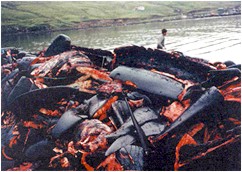
Whale slaughter on the Faeroe Islands. Photo courtesy: Sea Shepherd
The Danish Government allows the killings. At one time whalemeat was a staple diet of Faeroe Islanders but in recent years medical advice has told the islanders not to eat so much of it. More than 265,000 small cetaceans in total have been reportedly killed in the Faroe Islands over the years, mainly between the months of June and October, according to Sea Shepherd - some 1,500 since July 2013.
What happens in the Faeroes is so much of a contrast to how whales and dolphins are valued in Irish waters, which are a protected area and where the sight of whales and dolphins is a treasured experience.
Another example of the differences in how Nature is perceived in different parts of the world is the deceitfulness of the Japanese where the killing of whales is concerned. Japan has caught and killed 30 minke whales in its first hunt since and despite the International Court Justice ruling earlier this year that specifically banned such practices. The Japanese Government claims that these killings were for scientific research, a statement that is not fooling anyone.
BUILT-IN NAVIGATOR
Turning back to the positives of Nature, I was enjoying a leisurely lunch moored in Crosshaven when the gull photographed here arrived to seek food.
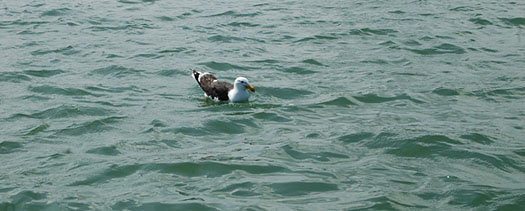
A good navigator
A few titbits were passed outwards and I admired his navigational expertise. From his low perspective on the water the slight swell would obscure the titbits as the floated outwards, but unerringly the bird could pick up any titbit, homing in on it, no matter what angle it approached from. It was intriguing to watch. Built-in navigation?
SUCKER GETS ANOTHER CHANCE
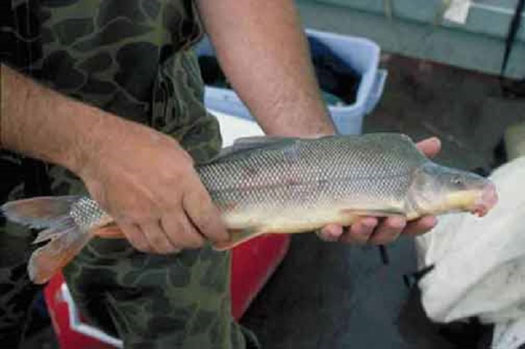
A Razorback suckerfsh
Nature can recover from setbacks, which has been shown this week in the Grand Canyon National Park in the US where the "extremely endangered species of fish" - Razorback Suckers - have been discovered spawning in the canyon after being absent for more than two decades. The photograph by Johnson Joames of the US Fish and Wildlife Service shows that the endangered fish has returned to the lower part of the Colorado River within the Grand Canyon National Park. Despite their name, razorbacks are harmless fish, characterised by the high sharp-edged hump behind their head.
CHANGING NATURE IN CORK HARBOUR
The use of Nature does bring changes, which are very apparent in Cork Harbour where I sail. Three massive wind turbines are now in place, quite dominant as they are almost 500 feet high. By contrast, Dublin's Spire in O'Connell Street which has been described as soaring to infinity is only 390 feet high. I am not advancing this as one up for Cork! Opinions about the turbines are mixed. They were built without any major public planning opposition to provide power for the pharmaceutical industry in Ringaskiddy. There is, however, opposition to the renewed plans for the building of a new container port at Ringaskiddy. Cork Port's plans for this are being objected to by harbour residents. Noise and other pollution aspects are the reason.

New look Cork Harbour
The Port company says the development is essential economically and because of the increasing size of ships. They maintain Ringaskiddy is the natural place for the development. Local opposition says the new port should not be built in the middle of a residential area and allege that it will affect leisure use of the harbour. Another issue about the Natural environment.
Finally, the beauty of Nature and what man creates, my photograph shows the sight of a beautiful wooden sailing vessel in Cork Harbour where traditional boats gathered at Crosshaven last week and whose next gathering will be in Cobh next weekend.
Respecting what Nature provides is a hallmark of quality in human beings.
Twitter: @afloatmagazine @TomMacSweeney



























